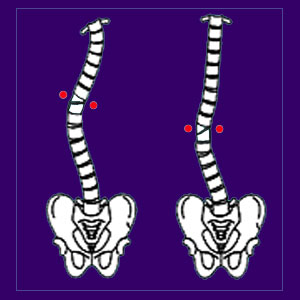
Hemivertebra is a diagnostic classification of a wedge-shaped or partial spinal bone that is often implicated in causing back or neck pain, as well as a multitude of possible neurological consequences. Wedge-shaped vertebral bones are also considered a major known source of lordosis, kyphosis and scoliosis.
Many people demonstrate various types of wedge-shaped spinal bones and do not have any symptoms whatsoever. Therefore, the facts of hemi-vertebral bones remain shrouded in much mystery for the general public, since most people typically consider them as being universally pathological.
This essay explores the occurrence of hemivertebrae in the human spine and examines the causes and consequences of this phenomenon. If you are affected by a wedge-shaped spinal bone, then this is the ideal research material for you.
Types and Causes of Hemivertebra
All hemivertebrae are incomplete spinal bones wherein only one side of the bone forms. These are virtually always congenital defects and are present from birth, often without known causation. There are many classifications and sub-classifications of partial wedge-shaped vertebral bones and each will have unique symptomatic potential:
Fully free spinal segments are not attached to the spinal bones below or above and may or may not occupy a full vertebral level unto themselves. These free bones typically have the greatest cconsequence on spinal form and functionality.
Semi-segmented bones are joined on one side to either the vertebra above or below and are not separated from this joining by a spinal disc. In much less common cases, a partial disc might exist between the hemi bone and the fully formed vertebral bone above or below.
Attached hemivertebrae might be fused to the bones above and below and most often exist without any spinal discs in between these bonds. In less common cases, a full or partial disc might exist at one or both bonded locations.
Many cases of vertebral wedging exist for idiopathic reasons, although the following conditions are often associated with their formation: Gorlin syndrome, fetal pyelectasis 3, OEIS complex, Jarcho-Levin syndrome, mucopolysaccharidosis 9, Aicardi syndrome, gastroschisis 3,VACTERL association and cleidocranial dysostosis.
Hemivertebra Consequences
Since any hemivertebral bone will disrupt the symmetry of the spinal column, there are almost always visual abnormalities demonstrated by the patient and symptoms might be a direct result of these structural chances.
Typically, patients will demonstrate changes to the curvatures of the spine, including lordosis, kyphosis and scoliosis. Dorsal hemivertebral bones tend to encourage hyperkyphosis while ventral wedge vertebral encourage hyperlordosis. Lateral wedge-shaped bones will result in scoliosis and possibly lordosis and/or kyphosis, as well.
Unto themselves, hemi-shaped vertebral bones are not inherently pathological. However, since they do inherently alter the form and function of the spine, they can become the root cause of pain and neurological dysfunction due to the following causations:
Mechanical dysfunction can affect the spine, potentially causing pain.
Compression of the spinal cord and/or spinal nerves might occur due to canal stenosis or misalignments.
Soft tissue pathologies can develop in response to stabilization efforts by the surrounding musculature.
Atypical Vertebral Formation
Many hemivertebrae might create visual abnormality, but do not necessarily cause any pain or disability. Others are unfairly blamed for causing pain or dysfunction, when in fact, there is another root cause for these symptoms to exist. However, since all hemivertebral bones have symptomatic potential, they should always be thoroughly investigated for their possible role in any pain or neurological dysfunction expression.
Treatment for problematic bones can be achieved using symptomatic conservative care or curative surgical care. Many cases of hemivertebral formation can be completely resolved surgically, while others might leave residual effects even following operative intervention. If treatment is needed or wanted, we always recommend seeking out a specialist in vertebral abnormality correction, as this is a very niche surgical undertaking that should always be performed by an expert in the field.





